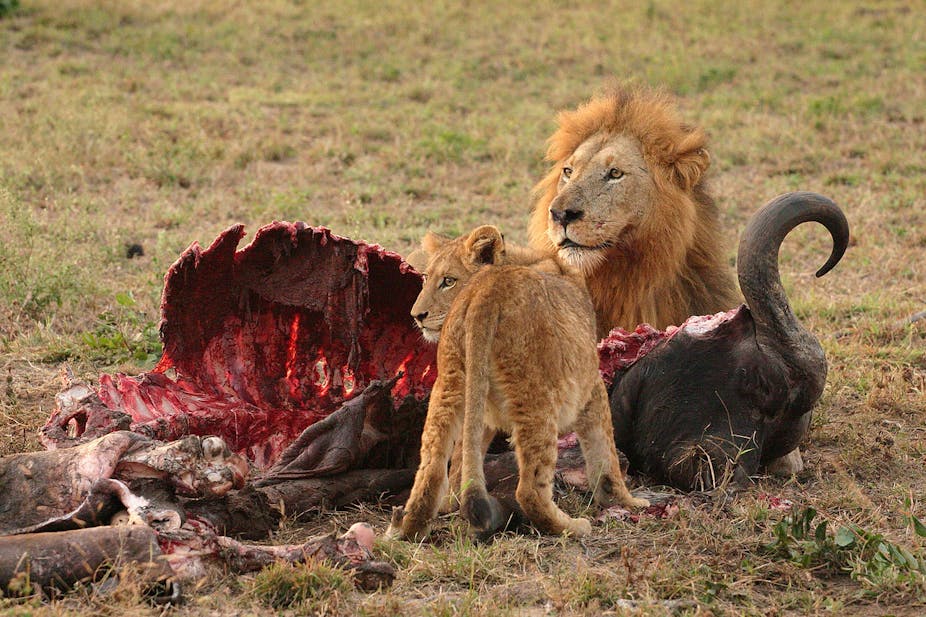Criticism of sport hunting nearly always focuses on whether hunting is cruel or not. A good example was provided by the recent controversy surrounding Melissa Bachmann, a keen hunter and television personality who posted a photo of herself with a lion trophy on Facebook. She has been heavily criticised, even threatened for her actions.
But there are more interesting and important questions – what does sport hunting lead to? And could limited hunting actually help populations increase?
A study published today from researchers at Imperial College London, Stirling and Cape Town Universities uses population models to map the effects of a hunting quota on lion numbers. In its model, the paper found a lion population would rise from 30 to 100 individuals in 30 years. This in turn would allow the quota of lions allowed for hunting to go up from 15 to 22. With hunters prepared to pay US$125,000 to take home a lion trophy, this means the land could be profitable as wild habitat, and hence conserved, rather than turned over to farming.
The idea of setting quotas for sport hunting to increase numbers of lions is anchored to a particular, economic valuation of nature that has become popular. This approach holds that the application of market principles can solve everything from loss of charismatic species such as pandas, rhinos or elephants, to mitigating the effects of climate change. Examples include payments for ecosystem services (PES), or the “natural capital” model, carbon trading, adopt-an-animal schemes, green certification labels, ecotourism and sport hunting.
The potential of a green economy
These are central pillars of the “green economy”, backed by a UNEP report that was discussed centre stage at Rio+20 in 2012. The green economy assumes jobs, income and benefits will be developed by encouraging environmentally sustainable behaviour. Sport hunting of lions fits right in to this. But for many, placing our trust in the green economy is a worry – it could lead to concentrations of money and power, it might deepen existing inequalities, and there is no guarantee that it will lead to a greener economy in the future.
NGOs such as Born Free Foundation, Humane Society International and International Fund for Animal Welfare have all argued against sport hunting, citing its cruelty and pointing to scandals such as canned hunting. Other conservation NGOs, such as WWF take a less critical view, and do not oppose sport hunting per se, reflecting the long historical relationships between hunting and conservation. This is an important and worthwhile debate, it is one that needs to be had, but it misses a critical point: if we rely on economic incentives to conserve rhino, for example, what happens when those incentives are reduced?
Hunting to save them
South Africa has permitted sport hunting of white rhino since 1968, and it provides some lessons that we need to take seriously. IUCN African Rhino Specialist Group data indicate that that since hunting began the numbers of Southern white rhino have increased from 1,800 to over 20,000. There is no doubt that sport hunting and expansion of rhino numbers occurred simultaneously. But these days most rhino are in private hands because owners have an economic incentive to increase rhino range and numbers: the more rhino they have, the more they can sell to sport hunters. This apparent success story is more complex than it first appears.
The trade in rhino parts (notably rhino horn) is banned under the Convention on the Trade in Endangered Species (CITES), so rhinos can only be “sold” as sport hunting trophies or as a star attraction in safari tourism. As demand for rhino horn grows, the only way of obtaining it is via increasing levels of illegal hunting. As a result, the cost of protecting rhinos has risen, while the revenue from hunting rhinos has stagnated or even fallen. A key threat that rhinos face today is disinvestment by private owners who cannot afford to keep them. This has led to vocal calls to legalise a rhino horn trade to boost incentives for private owners – at the moment in “rational” or market terms, it does not make sense for private owners to continue to pay the considerable costs of their upkeep.
Trophy cash, but for who?
A second critical, but often invisible, concern is that the revenues from sport hunting merely concentrate power and wealth in existing hands. It is common to hear the argument that hunting provides an important source of income and employment for rural communities in poorer parts of the world. It is the case that sport hunting brings jobs for some, and income for some. But the economic benefits are not spread widely, and the profits overwhelmingly go to those able to set up “luxury safari experiences” on private land in the first place – the rich.
Poorer rural communities are relegated to more menial and lower paid tasks – they are the cleaners, cooks, waiters, guides and rangers, and not (with some exceptions) the owners. The narrow focus on jobs and income, the rush to launch new tourism and sport hunting ventures means that often we do not consider other approaches to developing the local economy.
If the objective is solely to increase lion numbers, then yes, sustainable hunting quotas are likely to work, just as they worked for white rhinos. But, with serious concern over social inequality, we should ask whether increasing animals numbers is the only measure we wish to apply.

